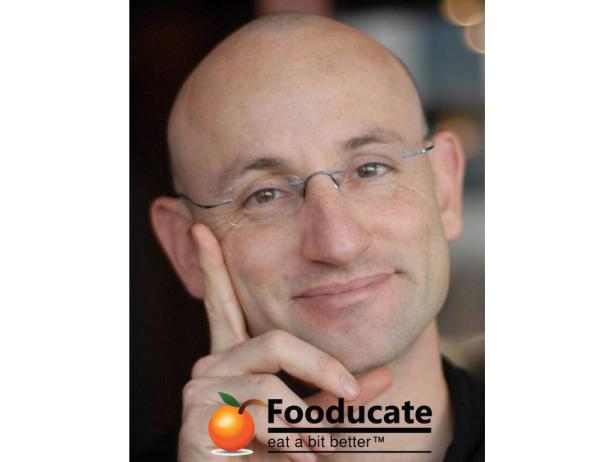Talking with Fooducate Creator Hemi Weingarten

Fooducate is an easy-to-use, free smartphone app that helps you make healthier food choices. To use it, scan a packaged item's bar code or search for food items and you'll see its letter grade (A to D) with an explanation of its nutritional benefits, or lack thereof. When I recently introduced this app to a table of women they couldn’t believe their favorite so-called “healthy” snack foods scored so low (they received a C- or D+). They now use it to help them make more healthful food choices. I had the opportunity to speak to Fooducate creator, Hemi Weingarten, to learn more about it.
A few years ago, when my children were still babies, we bought a glow-in-the-dark yogurt in the supermarket. I was curious as to the source of the bright pink color and read an ingredient list for the first time in my life. I was shocked to discover Red #40, a synthetic dye, with potential links to hyperactivity and cancer is being used in kiddie yogurt. In Europe it is banned and beet juice is used instead.
I started researching the modern food industry and discovered many other ingredients or processes for food manufacturing that seemed to make good business sense for companies, but were not in my family’s best interest. Fooducate started out as a blog to help myself and other parents be more cognizant of the food we buy for our families. When smartphones started to become popular, I put together a team and we built the mobile scanning app.
Fooducate’s philosophy is relatively simple, but the actual algorithmic implementation is quite complex. The algorithm looks for minimally processed, real foods with intrinsic nutrients. These will score better than processed foods that are poor in built-in nutrients. Fooducate’s analysis is based on information that appears on a product’s package including the nutrition facts panel and the ingredient list. We do not receive any additional input from manufacturers.
The ingredient list is very important as it tells the story behind the nutrients. Imagine a piece of cardboard that was sprayed with 11 vitamins and minerals, then coated with “natural” flavors, peppered with an artificial sweetener, and colored with an artificial yellow dye. Under some rating systems, this product would actually score very high as it is zero calories and full of nutrients. Not at Fooducate. We look for real ingredients. Artificial colors and sweeteners detract from a product score. The use of whole foods adds points.
Some people have likened Fooducate to taking both your grandmother AND your dietitian with you to the supermarket for shopping advice. We like that.
We run quality assurance tests on our database. These include product data verification, for example, making sure the nutrient values were entered correctly, or that there are no spelling mistakes in the ingredient list. Another quality assurance measure is random tests on products by nutrition experts to verify that the grade a product has received makes sense. Lastly, our users provide us with continuous feedback, which may include requests to review certain product’s ratings if they seem off.
The highest grade is an A. The lowest grade is a D. Want an A+? Grow it in your backyard or cook it yourself. No foods get an F, because with so many people going to bed hungry here in the United States even today in 2012, it doesn’t seem fair to ostracize any one product that would keep someone’s belly full.
Yes, we worked and continue to work with registered dietitians as well as labeling experts and scientists. Professor Adam Drewnowski, Director, Nutritional Sciences Program, University of Washington and a world-renowned leader in innovative research approaches for the prevention and treatment of obesity is on our advisory board.
- There’s an FDA loophole that allows manufacturers to label trans-fat as zero as long as it is under half a gram per serving. Manufactures state the product has a small serving size just so the value will be zero. In reality you may be consuming a gram or more of trans-fat.
- Low-fat foods may save you a few calories per serving, but have so many fillers and additives instead, that they are actually a worse product than full-fat versions of the same food.
- Some products are so full of sugar that manufacturers would need to state sugar as the first ingredient in the ingredient list. In order not to do this, they state 3 or more sugars in the ingredient list (Brown sugar, corn syrup, molasses, for example) so that the product will seem healthier.
Our product database is updated by our users! When somebody scans a product we don’t have, we ask them to take three pictures for us: the front of the package, the nutrition label, and the ingredient list. We get thousands of submissions every day and then add the new products to our system.
Not just moms. But we were especially happy to read a mother’s story about going to the supermarket with her children. She lets them choose their own cereal and snacks, just so long as they scan each product with Fooducate and choose only items graded B or higher.
Fooducate’s goal is to help millions of shoppers choose healthy, tasty, and affordable food, and to affect positive change on the food industry. Fooducate’s mobile apps and daily blog help people find better food at the supermarket. The company was founded by Hemi Weingarten, a tech entrpreneur, foodie, and father of three young children. For more information about Fooducate, please visit www.fooducate.com.

























